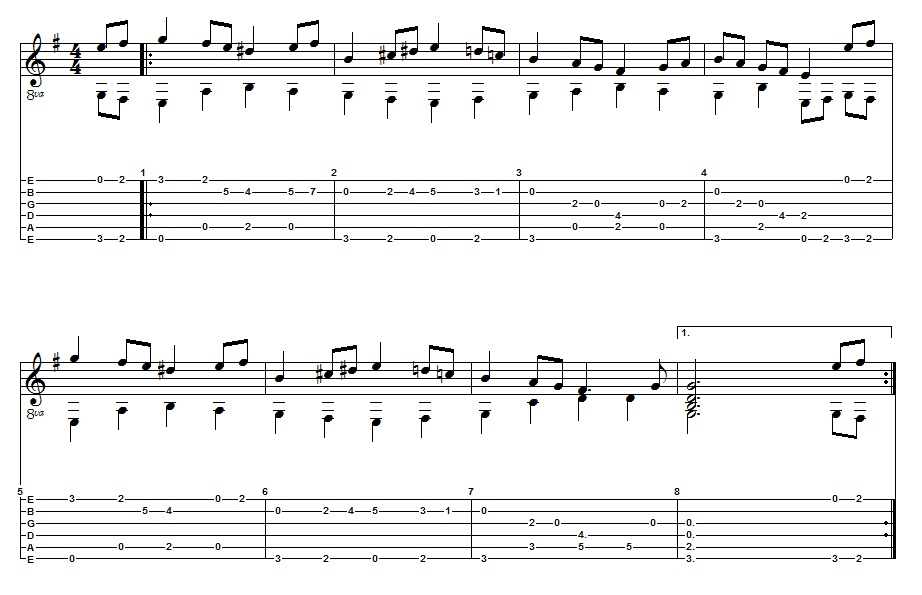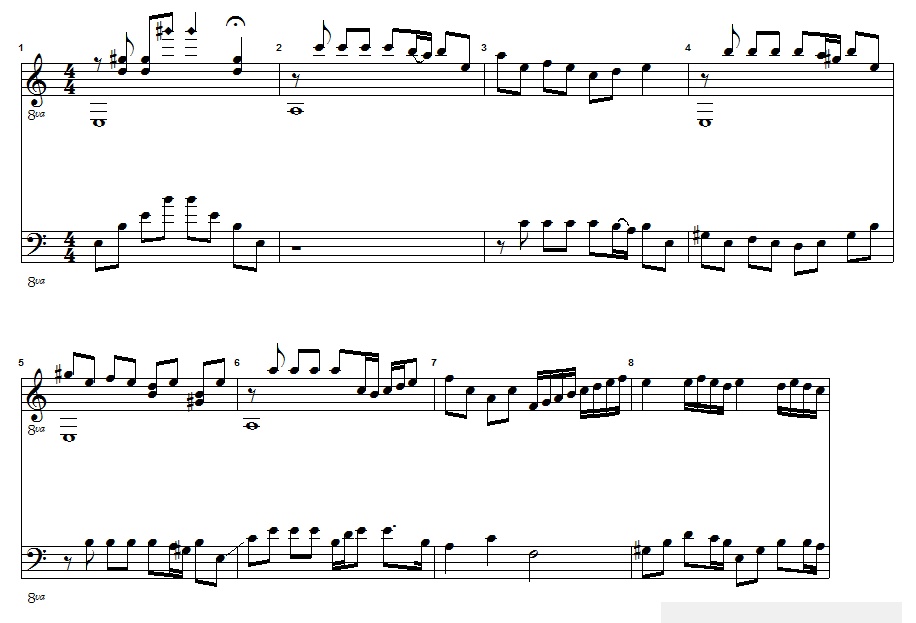
Appendix VI - Lesson 25
Counterpoint
Notes to Appendix VI - Lesson 25
The study of counterpoint has been the pinnacle of study for composers for more than 300 years. The roots of Counterpoint can be traced to the Renaissance Era and it may be older than that. No one ever did more or was better than Mr. Counterpoint, J. S. Bach. His Art of the Fugue covered probably the most difficult and complex of all the forms of music, the Fugue, and one which all great composers since have revered. Jazz is no stranger to counterpoint and today's Jazz groups often excel in inventing two- and three-part inventions, as Bach would have called them.
In the late 1960's we all were introduced to Bach through the music of the Jazz-Rock group, Jethro Tull, and its flautist Ian Anderson playing the Bourree in E minor from the 1st Lute Suite. This piece was in 2-part harmony. It is a long time favorite of classical guitarists, and guitarists that aren't particularly interested in classical music. Look at the walking bass in the 1st part of that classic (the entire composition is in the TEF section of this lesson):

Bourrée BWV996 by J. S. Bach (the 1st Part)
This example by Bach is the first or A part of a two-part composition. Look at the standard notation not as music, but rather as a piece of visual art. Note how the lines come close to each other and then spread out. In a video he recorded about acoustic jazz guitar techniques, Charlie Byrd tells us that we can practically never go wrong when one instrument's melody is ascending and the other's counter melody is descending and vice-versa. It's when both (or all) voices go in the same direction that causes us problems. Charlie Byrd's music is particularly interesting in a study of counterpoint. He was a classically trained musician that formally studied music composition, as many great Jazz musicians such as Dizzy Gillespie and Dave Brubeck. His arrangements for his groups always showed this training. He particularly liked to improvise single note lines against another instrument such as a bass or a solo instrument. Here is an example of Charlie's counterpoint from his recording of the Duke Ellington classic "I Let A Song Go Out of My Heart":

Counterpoint in a Turn-around by Charlie Byrd
"I Let A Song Go Out Of My Heart" has an A1, A2, B(ridge), A2 structure. The above example of a turn-around occurs in at the end of the A1 part. In the TEF's for this lesson there is a complete transcription of the recording for your study.
As kids we became exposed to counterpoint by singing children's canons, like "Row, Row, Row Your Boat." Canons are an important part of Counterpoint. Some of us have even gotten married to the music of the famous Canon in D by Johann Pachelbel. Continuing our study of the works of Charlie Byrd, here is a fragment of the famous "Theme from Love Story" by Franįis Lai. Charlie is playing one melody and his brother Joe is playing a counter melody in the style of a canon (the entire transcription also appears in the TEF's for this lesson):

A Psuedo-Canon Between Guitar and Bass
Charlie starts the interplay in the 2nd measure of our example, while the bass is tacet. In the 3rd measure the bass imitates the guitarīs 2nd measure while the guitar is continuing the cantus firmus. Note that the bass is not playing an exact copy of the the guitarīs melody, but it is close enough that our ears cause us to think "oh wow! A canon." (well, some of us at least.) There's only about 8 measures of that, as undoubtedly Charlie is remembering our earlier stated Bryl-creme axiom "A little dab'll do ya!".
A soloing instrument playing against a bassist who is also improvising is the backbone of exciting Jazz. A popular expression for a widely used bass technique is the "walking bass". There are a few fingerstyle guitarists that have based their careers on this technique. Blues recordings from the 1920's and 1930's have many examples of walking bass, or counterpoint.
Listen to the music of any traditional Dixieland group, and one will hear 3-, 4-, 5-part harmony, all being improvised on the spot.
Since the Renaissance Era, classical counterpoint has had some strict rules, such as avoid parallel octaves, unisons, or fifths, unless we have a good reason like accentuating a phrase. But when we do that, we lose our counterpoint and are just emphasizing a single melody. Refer to Charlie Byrd's example above of "I Let A Song Go Out Of My Heart." In the first measure Charlie plays the melody as octaves to emphasize it. Some guitarists, notably Wes Montgomery, made a career out of an octave style. When used sparingly, such as this example, it focuses our ears.
With such an important and complex subject, I have always been a bit bewildered wondering why Mickey gives so little attention to Counterpoint, with one lesson?
About the Exercises: Mickey has given us four exercises with examples of counterpoint. All of the examples are from previous exercises from this volume. As they are very short, I've combined Exercises 62, 63, and 64 into one TEF.
Exercise 62 has us hold two notes while the bass line moves down then up.
Exercise 63 starts with the same chord but the melody line is also moving with chords on beats 1 and 3.
Exercise 64 is essentially the same as Exercise 63 except the chords' extra voices are removed to give us to single note lines. Note it simplifies fingering somewhat.
Exercise 65 is taken from Lesson 19's Exercise 49, "Everything Happens To Me." Instead of the accompaniment of arpeggios on the guitar, Mickey uses the bass notes of the arpeggio as half notes giving us the counter melody. I've included a variation of Exercise 65 with the countermelody dropped an octave where possible. Compare it to Mickey's original, not as one might be better than the other, but rather now you have two different tools in your tool box
In Summary: Counterpoint adds interest to any phrase by dividing the attention. Although the technique transgresses musical periods, it adds a fresh take on practically any arrangement from any musical period. .Counterpoint techniques can be used in writing bass lines for our arrangements, in addition to using it for the guitar part. It is still another extremely useful tool for our tool box. Many community colleges offer a Counterpoint course from their music departments. This is a great way learn more about this musical technique and to meet and make friends with folks of like interests.
Have fun with your new found tool!